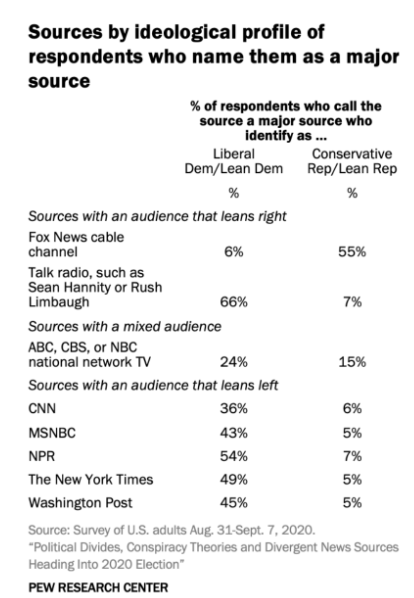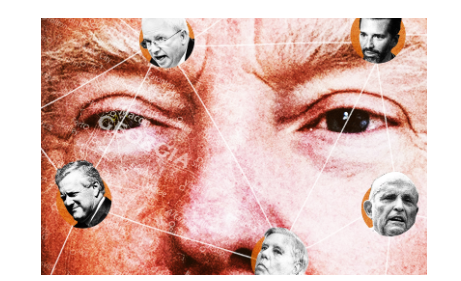
The Washington Post also known as the Post was founded in 1877 by Stilson Hutchins. It is an American daily newspaper published in Washington, D.C. and it is the most widely circulated newspaper in the Washington metropolitan area. It is regarded as one of the leading daily American newspapers. According to Statista, the Washington Post ranks number three in online-only news with 2.7 million online news subscribers. They have also received 70 Pulitzer Prizes dating back to 1936.
As a leading news organization, it is important to look at whether the Washington Post shows any political bias in its reporting. According to a Pew Research Study, the Washington Post’s’ audience is consistently left of center. The Washington Post notes that “People who read BuzzFeed, Politico, The Washington Post, and The New York Times all tend to be more liberal.”

Source: Pew Research/Washington Post
In this article, we will analyze the newspaper’s coverage and editorial decisions to determine if there is a discernible political bias in their reporting. Through our analysis, we hope to provide a comprehensive answer to whether the Washington Post is biased and shed light on the factors that contribute to media bias in general.
How Does Biasly Rate News Sources?
Biasly’s algorithms produce bias ratings to help provide multiple perspectives on given articles. Biasly has analyzed 200,000+ news articles from more than 3,200 news sources through our A.I. technology and team of political analysts to find the most factual, unbiased news stories.
Biasly determines the degree of political bias in news sources by using Biasly’s Bias Meter Rating, in which Biasly’s team analyzes media sources’ reliability and bias and produces three scores, a Reliability Score that measures the accuracy of media sources; an A.I. Bias Score, evaluated by A.I.; and an Analyst Bias Score evaluated by political analysts. These scores are rated based on seven rating metrics including Tone, Tendency, Diction, Author Check, Selection/Omission, Expediency Bias, and Accuracy. These metrics help our analysts to determine the political attitude of the article.
Our A.I. machine-learning system employs natural language processing and entity-specific sentiment analysis to examine individual articles and determine their bias levels. By analyzing the key terms in an article such as policies, bias phrases, political terminologies, politicians, and their nicknames, the algorithms can rate the attitude of the text. Bias scores range from -100% and 100%, with higher negative scores being more liberal and higher positive scores being more conservative, and 0% being neutral.
Is the Washington Post Politically Biased?
In 2021, the Washington Post corrected two articles dating back to 2017 and 2019. Both articles were about the Steele Dossier which led to accusations of then-President Donald Trump colluding with Russia. Those claims were later debunked and this article was published “The Washington Post corrects, removes parts of two stories regarding the Steele dossier” and states:
“The newspaper’s executive editor, Sally Buzbee, said The Post could no longer stand by the accuracy of those elements of the story. It had identified businessman Sergei Millian as “Source D,” the unnamed figure who passed on the most salacious allegation in the dossier to its principal author, former British intelligence officer Christopher Steele.”
In the correction, the Post admits that Steele’s dossier consisted of “raw information and unconfirmed tips from unidentified sources” but the news organization still made the decision to publish unconfirmed information from these anonymous sources.
Biasly’s A.I. Bias Score for the Washington Post sits at Somewhat Liberal and it gave a Policy Leaning Somewhat Liberal which means it provides political coverage from an American liberal political perspective. Praise for liberal politicians and policies as well as dislike toward Republican policies and politicians contribute to this rating.
Biasly’s scores closely align with determinations by other third-party bias research agencies with Left-leaning ratings. Readers like you are more likely to have a strong opinion of the Washington Post based on your political leaning because of their tendency to favor liberal causes and people as represented by Biasly’s Somewhat Liberal rating. In the remainder of this article, we’ll talk about ways to identify this bias so you can separate the opinions from the facts and become a more informed consumer of news.
Before we begin, we need to discuss bias. Bias is a natural function of humans, and we can express it both consciously and unconsciously. Bias is one of the most fundamental forms of pattern recognition in humans. This isn’t to lower the bar and say that “all things are biased,” but to explain the process in which we may come to trust certain news organizations that display patterns of coverage.
On the media’s part, there is an incentive to retain audiences, encourage them to purchase subscriptions, and rate products positively. Bias is a two-way street, people want to see news stories about things they care about, and the media needs viewers to continue their operations. This creates a positive feedback loop that influences what stories are covered and from what perspective. This also explains the actions of more liberal news organizations.
Analysis of Bias in The Washington Post Online Articles
A 2020 Pew Research Study found that 45% of those who relied on the Washington Post for the majority of their news identified as Liberal. Only 5% identified as Conservative. Given that the majority of their audience and paying subscribers are liberal-leaning, does that mean the Washington Post is really biased? We’ll look at some of their articles in more detail below to identify the signs.

Source: Pew Research
When determining bias, some of the most common metrics used include Tone, Author, Diction, Tendency and Expediency Bias which are the primary metrics we’ll focus on below. Tone refers to the attitude of the writing and is related to but distinct from diction, which is the writer’s word choices. The Author metric refers to the author of the article and his or her demonstrated stance on issues through past articles and social media posts.
The first article we will look at is “How Donald Trump tried to undo his loss in Georgia in 2020”. Biasly has rated this article as -98% on the Bias Meter, or “Extremely Liberal.” Part of the reason for this rating is that it portrays Republican Politicians very negatively compared to Democrat politicians.
There were mostly positive sentiments for Joe Biden and there were around 43 negative sentiments for Donald Trump. The tone of the article is mostly negative towards Donald Trump and his allies and leans extremely liberal throughout the entire article.

The Washington Post “How Donald Trump tried to undo his loss in Georgia in 2020”.
The images and videos used by the authors in this article also add to the negative tone. The main headline image (as shown pictured above) is a picture of Trump with other people’s faces superimposed with lines drawn between them which mirrors an “investigation board” you might see in a TV show.
Based on the headline “How Donald Trump tried to undo his loss in Georgia in 2020” and its leading image, the article sets an unfavorable tone toward Trump and his allies.
The authors also use multiple videos and audio recordings, all of which are negative towards Trump, Rudy Guilliani, and others who were directly involved in attempting to prove that the 2020 election was fraudulent.
The article is written about the ongoing legal issues facing Donald Trump leading up to the 2024 election, but the authors do not clarify that these are active cases and that Trump has yet to be convicted of any wrongdoing. Throughout the article, Amy Gardner, Kati Perry, and Adriana Usero make use of extreme language that is unfavorable towards Donald Trump. The tone of the article is very negative towards Trump in that the authors focus on evidence provided by the Fulton County District Attorney’s office. For example, the authors discuss one witness’s testimony:
“He alternately berated Raffensperger, tried to flatter him, begged him to act and threatened him with vague criminal consequences if the secretary of state refused to pursue his false claims, at one point warning that Raffensperger was taking “a big risk.”…”We hear they’re shredding thousands and thousands of ballots,” Trump said on the call.”
The indictment documents and previous investigations list the accusations that will be presented in court against the defendant, but the actual trial and outcome are still undetermined. Therefore it is inaccurate to portray the indictment as the complete truth, since the defendant and his legal counsel may present different evidence at trial. The United States government through the prosecutor has to prove their case against a defendant beyond a reasonable doubt, which is why a defendant is innocent until proven guilty. If an author is discussing an ongoing legal case they should only discuss the facts so as not to sway the public perception of the defendant.
To sum it up, the authors do strive to explain the lengthy ongoing legal battles that former President Trump is facing. Although the majority of the story focuses on Trump’s supposed wrongdoings, they do acknowledge that the investigation is ongoing. They write:
“Regarding Georgia, he and his allies have maintained that they were following the advice of counsel and were protected by the First Amendment as they advocated for investigations into alleged voting irregularities.”
The authors rely heavily on the January 6th Committee Investigation as well as key players such as Brad Raffensperger who is Georgia’s Secretary of State and former New York City Mayor Rudy Giuliani. Both men are also being investigated for the events that occurred during the 2020 election.
The authors show bias when discussing the events that occurred on January 6th at the United States Capitol.
“They were interrupted when thousands of Trump supporters descended violently on the U.S. Capitol. Armed Trump supporters descended on the Georgia Capitol that day, too — forcing Raffensperger and his aides to evacuate. The moment solidified his view of the president.”
According to an article by Reuters, the protests at the Georgia state capitol were peaceful and they could not verify that anyone was carrying assault-style weapons. Reuters also claims that Raffensperger and his staff left their offices early out of an abundance of caution and were not forced to evacuate due to violence at the state capitol. As for the U.S. capitol, five people did die that day but 4 out of the 5 victims were Trump supporters. One Trump supporter, Ashli Babbitt, was shot and killed by capitol police and she was the only victim of gun violence that day.
There was one capitol police officer who died that day. Originally it was reported he was struck in the head by a fire extinguisher. A medical examiner reported that he did not die of blunt force trauma and it is believed that he was pepper sprayed but they have stated that he died of natural causes. Two other victims died of natural causes that day and one woman was crushed by the crowd.
Ultimately the authors spin the story to support one perspective. All of this suggests that, while some elements of this article were more neutral, the article overall was found to be strongly left-leaning, which aligns with our analysis of the Washington Post consistently publishing liberal-leaning articles.
Analysis of The Washington Post Opinion Articles
Before we answer this question, we need to draw the distinction between opinion and reporting. While reporting is intended to be neutral, giving the reader the facts and quotes from primary sources lets them form their own opinion. Opinion-based journalism provides a platform for journalists to convey their personal opinions and convictions. Normally, it’s advisable to steer clear of excessive bias when crafting impartial news pieces but opinion articles are inherently subjective. Therefore, they are often less reliable but are still a great resource because they can offer valuable insight into complex issues that can be viewed from different perspectives.
While we saw elements of factual reporting in the analysis above, The Washington Post’s opinion pieces don’t seek objectivity but prioritize putting forth an opinion instead.
Consider the opinion article, “DeSantis’s Florida shows the disaster of more competent Trumpism” The title alone is loaded with bias because it contains language suggestive of a negative opinion or judgment about Trump and DeSantis. Specifically, the word “Trumpism” implies that DeSantis is following in Trump’s footsteps which liberal readers would view negatively. The preemptive criticism of the former president and the Governor of Florida, as well as the bias present in the title, suggests that the author does not intend to provide a fair and objective reporting of the facts.
However, the article “Immigration can be fixed. So why aren’t we doing it?” has a more objective title, focusing on informing the reader rather than pushing an agenda. Reliable articles are marked by neutral language and facts from credible sources. Based on the title alone, it could be safely assumed that this article would be less biased than the one previous.
These articles, in addition to those above, are only a small representation of all of the Washington Post’s content. The Washington Post’s opinion pieces tend to be liberal-leaning but they do seem to post a balanced amount of Liberal and Neutral opinion pieces, they do not post conservative-leaning opinions. We know that opinion pieces are riddled with bias, but the news organization itself could remove bias by posting opinion pieces from opposite sides of the political aisle.
Who Owns the Washington Post?
The Washington Post is traded publicly and, therefore, is owned by its shareholders. The Washington Post has faced criticism over the years for favoring liberal policies and politicians.
In 2013 Jeff Bezos, the founder of Amazon, bought the Post after it faced consistent loss of profit. Since his acquisition, the Post has increased its online presence and is slowly becoming a profitable news organization. When Bezos first bought the company there was speculation he would influence what the Post would publish.
He initially took a backseat and simply focused on restructuring the company to make it profitable, however in 2023 he began to be more hands-on. There is a concern that Bezos would interject his personal politics into the news organization. In 2022, he was critical of President Biden and publicly expressed his opinion on Twitter in response to a tweet by the White House.
“Look, a squirrel! This is the White House’s statement about my recent tweets. They understandably want to muddy the topic. They know inflation hurts the neediest the most. But unions aren’t causing inflation and neither are wealthy people. Remember the Administration tried…”
There is concern that the current owner could use the news organization to help sway public opinions on topics that would benefit his businesses and investments.
How to Evaluate and Uncover Bias
It can often be difficult to tell if the news you watch is biased. If you have settled on a news channel, it’s usually because you trust the information you are gaining. Unfortunately, many trust the information they are hearing because it confirms what they already believe. This is referred to as “confirmation bias.” It is important to challenge your beliefs and get third-party verification that what you are hearing is the full story. This is why we recommend using Biasly to compare different news stories side-by-side using our bias ratings to figure out what both sides think of a political issue.
Even though Biasly gave the Washington Post a Somewhat Liberal bias score, remember that bias varies by article, and the Washington Post does not exclusively publish liberal thought pieces. The Post does sometimes post neutral articles, but they do not publish any right-leaning articles or opinion pieces. Also, various kinds of articles naturally show different levels of bias. Think about it like this: regular news pieces are usually less biased than opinion articles. And even though all articles have some bias, some are just better at sticking to the facts than others, which is why it’s so essential to use Biasly’s News Check to help you determine how biased what you read is.























